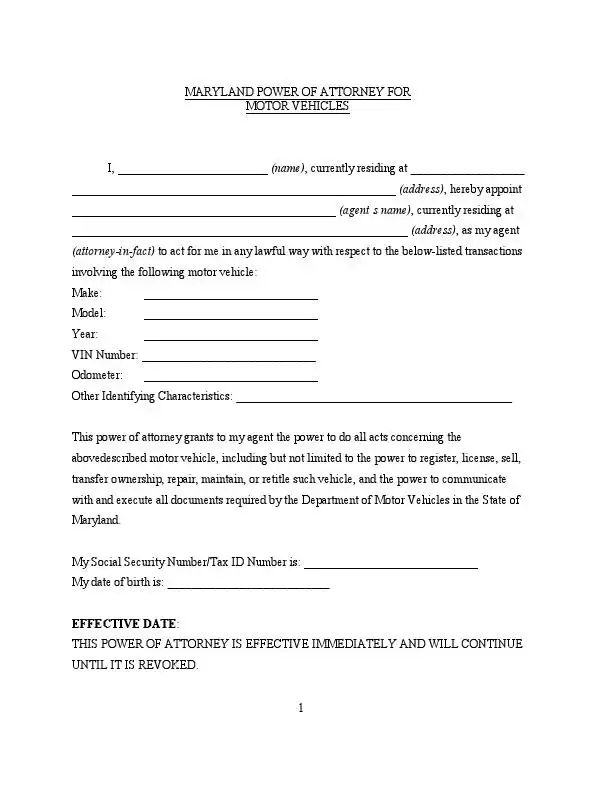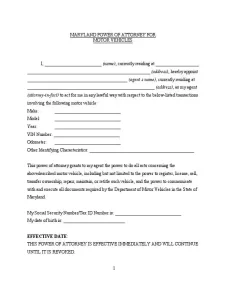Maryland Motor Vehicle Power of Attorney Form
The Maryland motor vehicle power of attorney, designated as Form VR-470, is a crucial document for authorizing someone else to handle specific matters related to motor vehicles on your behalf. This form is typically used to grant an agent the authority to sign documents and make decisions regarding a vehicle’s titling, registration, and sale.

Build Your Document
Answer a few simple questions to make your document in minutes
Save and Print
Save progress and finish on any device, download and print anytime
Sign and Use
Your valid, lawyer-approved document is ready
Unlike general Maryland powers of attorney, this document is specifically for actions related to motor vehicles. Here are the main components of Form VR-470:
- Principal and agent information. The form requires the full legal names and addresses of the principal (the person granting the power) and the agent (the person receiving the power to act).
- Vehicle details. It must include specific details about the vehicle(s) involved, such as the make, model, year, and VIN.
- Scope of authority. The form specifies the actions the agent is authorized to perform. These can include applying for a title, registering the vehicle, and handling the sale or transfer of the vehicle.
- Signatures. The principal and the agent must sign the form.
The Maryland Annotated Code, specifically within the Estates and Trusts title, Sections 17-101 to 17-204, outlines the laws regarding the creation, use, and termination of power of attorney. This document automatically terminates in case of the principal’s death, revocation by the principal, or expiration of the term specified in the document. If the principal decides to revoke the power of attorney, they should do so in writing and notify the Maryland MVA and any other parties that might have relied on the form.
Maryland Motor Vehicle Power of Attorney Form Details
| Document Name | Maryland Motor Vehicle Power of Attorney Form |
| State Form Name | Form VR-470 |
| Relevant Link | Maryland Motor Vehicle Administration |
| Avg. Time to Fill Out | 15 minutes |
| # of Fillable Fields | 43 |
| Available Formats | Adobe PDF |
Filling Out Maryland Vehicle POA
Completing the Maryland vehicle power of attorney (Form VR-470) is essential for authorizing someone to handle vehicle-related transactions on your behalf. This could include signing documents for car registration, titling, or selling. Filling out the form accurately ensures all transactions are processed smoothly.
1. Fill Out the Vehicle Owner Information
Begin by entering the full legal names (first, middle, last) and addresses (street address, city, state, zip code) of both the vehicle owner and, if applicable, the co-owner. This section must be completed accurately to establish who grants the power of attorney.
2. Specify the Agent’s Information
Enter the full legal name and address of the person you appoint as your attorney-in-fact. This individual will have the authority to act on your behalf regarding the motor vehicle specified. If the agent represents a business, include the business name and the representative’s capacity.
3. Provide Vehicle Details
Detail the vehicle information relevant to the power of attorney. Write the vehicle make, model, year, Vehicle Identification Number (VIN), and title number. Ensure this information is accurate to prevent any issues with vehicle transactions.
4. Define the Powers Granted
Check the appropriate boxes to specify the transactions the agent is authorized to perform: titling, registration, correction, or others. If selecting ‘Other,’ clearly specify the additional powers being granted.
5. Complete the Odometer Disclosure Statement
If applicable, fill out the odometer reading of the vehicle and check the appropriate box if the mileage is in excess of its mechanical limits or if there’s an odometer discrepancy.
6. Sign and Date the Form
Both the vehicle owner and the co-owner (if applicable) must sign and date the form. The agent (attorney-in-fact) also needs to sign and provide their capacity, along with the date. This section must be handled in the presence of a notary if required by Maryland law.
7. Attach Identification and Submit
Attach a copy of the vehicle owner’s driver’s license to verify identity. Once all parts of the form are completed, review the document to ensure all information is correct. Then, submit it to the Maryland Motor Vehicle Administration (MVA) or keep it on hand during relevant transactions.
